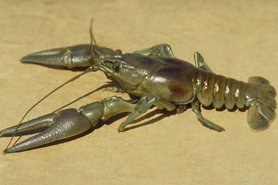Rusty Crayfish
(Orconectes rusticus)
The rusty crayfish (Orconectes rusticus) comes from streams in the Ohio River basin states of Ohio, Kentucky, Illinois, Indiana and Tennessee. The species was suspected to be transported via bait bucket by transient anglers who used them as bait while fishing. Today, rusty crayfish are also found in Wisconsin and surrounding states, the northeastern states, New Mexico and many areas in Ontario, Canada. In their regions, the rusty crayfish have dominated the native crayfish by taking over their habitat and natural forage at alarming rates.
Classification in Wisconsin: Restricted
- Ecological Threat
-
Outside their home range, rusty crayfish are likely to displace native crayfish and reduce aquatic plant abundance and diversity. In some northern Wisconsin lakes, it has eaten most of the aquatic plants, hurting the quality of the lakes. Aquatic plants provide critical habitat for fish and other marine animals and prevent erosion. By damaging underwater habitats, fish lose their spawning areas, protective cover and food. Fish that generally eat crayfish don't like the feisty, aggressive "rusty." It takes over the homes of native crayfish and has been known to eat fish eggs. Rusty crayfish reproduce quickly and females lay from 80-575 eggs.
- Identification
-
This crayfish measures two and one-half inches (not including claws) in length. Look for their large claws with black bands on the tips and dark, rusty spots on each side of their carapace (hard outer body covering). Their claws are grayish-green to reddish-brown and smoother than most other crayfish. The rusty spots may not always be present or well-developed on rusty crayfish from some waters.
- Distribution
-
See the reported Wisconsin locations of this species on the Aquatic Species Tracking pages.
Do you know of additional populations? Please send us a report.
- Control
-
Mechanical: Intensive harvest will not eradicate crayfish but may help reduce adult populations and minimize some impacts. The best method of control, however, is to prevent their introduction. Educating anglers, crayfish trappers, bait dealers and teachers about the threats of rusty crayfish will help reduce the risk of spreading rusty crayfish to new areas.
Chemical: Although there are chemicals that will kill crayfish, no chemicals are available to eradicate only rusty crayfish.
Prevention steps- Inspect and remove aquatic plants, animals and mud from the boat and equipment before leaving the boat launch.
- Drain water from your boat and equipment before leaving the boat launch.
- Throw away unwanted bait in the trash.
- Spray or rinse your boat and equipment with high-pressure and hot tap water, especially if moored for over a day. Or dry your boat and equipment entirely for at least five days.
- Do NOT use crayfish as bait. It is against the law in Wisconsin.
- Resources
- Sources for content:



